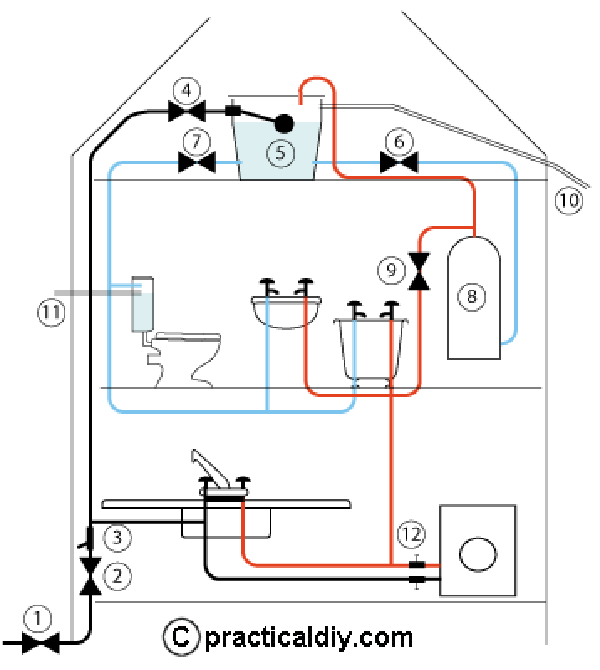Indirect water supply
An indirect water supply system is the most common type found in modern houses.
The mains water comes in via a rising main and directly feeds at least one cold tap at the kitchen sink with ‘potable’ water (i.e. water which is fit for drinking, cooking etc) and may also feed a washing machine, a shower and an outside tap etc.
The rising main also feeds a storage tank at a high point in the building from where the water is fed to all the other taps etc using gravity.

The items identified in the illustration above (NOTE that the central heating has been omitted for clarity) of an indirect water supply are:
- Water company stopcock - this can cut off all the water to the premises and is the point where the responsibility for the water pipe changes; up to, and including, this stopcock is the responsibility of the water supply company (even if the stopcock is on your land); from here to the house, is the house owners responsibility.
Make sure you know where this stopcock is located and, periodically, check that it's working - if you have a disaster in the house, you may want to turn the water off at this stopcock quickly. - Householders stopcock - this normally can cut off all the water within the house but the householder is responsible for it. It's usually located where the rising mains enters the house, often under the kitchen sink.
- Draincock - this allows the rising main within the house to be drained down at the lowest point.
- Stopcock - this stopcock can be used to isolate the rising main from the storage tank to allow maintenance without having to cut off all the water from the property.
- Storage tank with a ballcock float valve to control the water stored. The tank will typically hold from 230 to 360 litres (50 to 80 gallons) of water at the highest part of the building - the higher it is, the better the gravity feed pressure at the taps etc.
From 1991, the tank should be fitted with a close fitting lid; the expansion pipe from the hot water tank should pass through a grommet in the lid to keep out contaminations. - Gate valve which can isolate the cold water feed to the hot water tank.
- Gate valve which can isolate the cold water to the WC and taps etc.
- Hot water cylinder.
- Gate valve which can isolate the hot water to the taps.
NOTE: Without the valves 6, 7 and 9, any maintenance on the taps or hot water cylinder etc would require the storage tanks to be drained down - by using the appropriate valve to isolate the part being worked on, the amount of water wasted is minimised. - Storage tank overflow pipe - this takes any overflow of water from the storage tank out of harms way and deposits it outside of the building. It needs to be positioned so that any water flow is immediately noticed as it would indicate a problem.
Since 1991, the entry to the overflow inside the tank should include a filter to prevent even a small insect from entering the tank. - WC overflow pipe - this takes any overflow from the WC cistern out of harms way and deposits it outside of the building. It needs to be positioned so that any water flow is immediately noticed as it would indicate a problem.
- Inline valves to isolate water feeds to washing machine or dishwasher etc.
Stopcock or gate valve ?
A stopcock works like a tap in that when it is closed, a washer is pushed over an opening to stop the water flow whereas when a gate valve is operated a 'shutter' is wound across the opening. With a stopcock, some water pressure is usually required to lift the washer clear of its seat when it is opened to allow the water to flow; with a gate valve no pressure is required.
This basically is why stopcocks are used on the raising main (where the water pressure can be substantial) and gate valves are used on the water feeds from the gravity fed water storage tank (where the water pressure is a lot less and could be insufficient to lift the washer in a stopcock).
